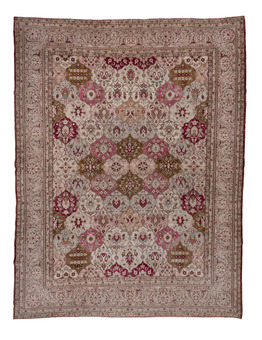Antique Handmade oriental carpet No. 66413 Kerman, ca. 1930 Iran 391 x 305 cm

Larger images (will open in new window)
Please click on the thumbnails below for a larger view
| main view |
Image 2 |
Image 3 |
Image 4 |
Image 5 |
 |
 |
 |
 |
 |
| Item Number: |
66413 |
| Name: |
Kerman, ca. 1930 |
| Country of Origin: |
Iran |
| Size: |
391 x 305 cm |
| Made:
|
ca. 1930 |
| Pile: |
wool |
| Design: |
floral / little medallion |
| Ground Color: |
beige / pink / khaki |
| Remarks: |
This is a unique handmade / hand-knotted / traditional oriental carpet
The pile of this carpet is made of wool |
 add to cart
add to cart
More about the provenance Kerman, ca. 1930 | Iran
Kerman is the capital city of the province of the same name. Kerman rugs have already been mentioned by the secretary of Shah Abbas I. (1587-1629) who spoke of "rugs with gold and silber threads". There are Kerman rugs preserved to this day since the 16th century throughout each century. Since the end of the 19th century until today Kerman with its large and esteemed rug manufactories is considered to be one of the most significant carpet production centers of Iran. Kerman is probably the only larger city of Iran whose population in its majority lives of carpet production. The most famous of the ca. 30 villages around Kerman in which rugs are made is called Ravar. The Kerman rug is often described as the "King of the carpets - the carpet of Kings". The Persian knot is used making them as opposed to the more spread Turkish knot which is more often used with Persian rugs.
This Oriental carpet has a so called "garden design" or as in Persian "Kheshti". The design of Oriental "garden rugs" represents sophisticated garden layouts from a bird's eye view. The oldest garden rugs date back to the 16th century. The legendary rug "Spring of Khosrow" of Khosrow the Sassanide king served as a template. The rugs are divided into fields which are separated by water ditches. The ditches in which often fish and ducks are swimming are flanked by bushes and flowers. Altogether garden rugs are an expression of the special Oriental love of floral beauty which peaked in fantastically laid out gardens.

